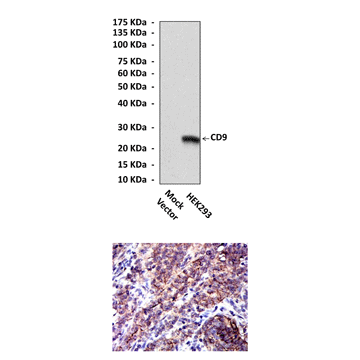Product Sheet CP10436
Description
BACKGROUND Tetraspanin is the generic term for the glycoprotein family containing four transmembrane domains. Members of this family form multimeric complexes with one another and other cell surface proteins including integrins, leukocyte antigens, and signaling molecules at specialized tetraspanin-enriched microdomains. As organizer, stabilizer, and facilitator of these molecular networks termed the “tetraspanin web,” tetraspanins regulate cellular morphology, motility, fusion, and intracellular signals. Tetraspanin CD9, a transmembrane protein known as motility-related protein-1, plays a pivotal role in regulating cell adhesion, motility, and proliferation, and has been regarded as an important metastasis-inhibitory factor of various human cancers.1
CD9 is associated with integrin adhesion receptors and it was reported that CD9 regulates integrin-dependent cell migration and invasion. Pro- and anti-migratory effects of CD9 have been linked to adhesion-dependent signaling pathways, including phosphorylation of FAK and activation of phosphoinositide 3-kinase, p38 MAPK and JNK. In addition, it was shown that CD9 specifically regulates localization of talin1, one of the critical regulators of integrin activation, to focal adhesions. CD9-deficiency leads to impaired localization of talin1 to focal adhesions and correlates with increased motility of breast cancer cells. In addition, it was shown that alpha 5 beta 1 integrin was directly involved in CD9 promoted cell migration. CD9 expression potentiates beta1 integrin high affinity conformation states and upregulates beta1 ligand induced binding site (LIBS), and in concert with alpha 5 beta 1, enhances cell motility to FN via a PI-3K dependent mechanism.2 Moreover, CD9 was also identified as a molecule that suppresses cellular motility and metastatic potential in a human lung adenocarcinoma cell line. Clinicopathologic findings indicated that CD9 is a predictor for better prognosis in adenocarcinoma of the lung.3
CD9 is associated with integrin adhesion receptors and it was reported that CD9 regulates integrin-dependent cell migration and invasion. Pro- and anti-migratory effects of CD9 have been linked to adhesion-dependent signaling pathways, including phosphorylation of FAK and activation of phosphoinositide 3-kinase, p38 MAPK and JNK. In addition, it was shown that CD9 specifically regulates localization of talin1, one of the critical regulators of integrin activation, to focal adhesions. CD9-deficiency leads to impaired localization of talin1 to focal adhesions and correlates with increased motility of breast cancer cells. In addition, it was shown that alpha 5 beta 1 integrin was directly involved in CD9 promoted cell migration. CD9 expression potentiates beta1 integrin high affinity conformation states and upregulates beta1 ligand induced binding site (LIBS), and in concert with alpha 5 beta 1, enhances cell motility to FN via a PI-3K dependent mechanism.2 Moreover, CD9 was also identified as a molecule that suppresses cellular motility and metastatic potential in a human lung adenocarcinoma cell line. Clinicopathologic findings indicated that CD9 is a predictor for better prognosis in adenocarcinoma of the lung.3
REFERENCES
1. Powner, D. et al: Biochem. Soc. Trans. 39:563-7, 2011
2. Kotha, J. et al: Exp. Cell Res. 314:1811-22, 2008
3. Kohmo, S. et al: Cancer Res. 70:8025-35, 2010
2. Kotha, J. et al: Exp. Cell Res. 314:1811-22, 2008
3. Kohmo, S. et al: Cancer Res. 70:8025-35, 2010
Products are for research use only. They are not intended for human, animal, or diagnostic applications.
Details
Cat.No.: | CP10436 |
Antigen: | Recombinant human CD9 fragments expressed in E. coli. |
Isotype: | Mouse IgG1 |
Species & predicted species cross- reactivity ( ): | Human, Mouse, Rat |
Applications & Suggested starting dilutions:* | WB 1:1000 IP n/d IHC 1:50 - 1:200 ICC n/d FACS n/d |
Predicted Molecular Weight of protein: | 25 kDa |
Specificity/Sensitivity: | Detects endogenous CD9 proteins without cross-reactivity with other family members. |
Storage: | Store at -20°C, 4°C for frequent use. Avoid repeated freeze-thaw cycles. |
*Optimal working dilutions must be determined by end user.
Products
| Product | Size | CAT.# | Price | Quantity |
|---|---|---|---|---|
| Mouse CD9 Antibody: Mouse CD9 Antibody | Size: 100 ul | CAT.#: CP10436 | Price: $457.00 |

